Over the last few years, affiliate marketing’s popularity has skyrocketed…
That’s because affiliate marketing is basically win-win for anyone who’s involved with it.
On one hand, merchants can leverage affiliate marketing towards raising brand awareness, expanding their customer base, and increasing conversions, sales, and customer engagement way more cost-effectively than almost all other traditional marketing channels.
At the same time, affiliate marketing enables ordinary folks to pocket thousands of dollars of monthly commissions online with virtually ZERO monetary investment simply by promoting already existing products through their blog, YouTube channel, and/or social media profiles.
Affiliate marketing has made businesses millions and ordinary people millionaires – Larry Bussey
However, you don’t have to take my word for it…
Whether you’re after building an income online as an affiliate publisher or launching an affiliate program for your already existing business, this list of 30+ Affiliate Marketing Statistics is going to help you fully understand if affiliate marketing is worth the trouble or not.
Enjoy!
Important Note:
All the Affiliate Marketing Statistics outlined in this list are backed by solid research conducted by reputable institutions such as Awin, Forrester Consulting, and Statista among others, NOT on opinions and conjectures of random people and sources.
30+ Affiliate Marketing Stats
1. It’s Worth Over $14 Billion
According to an Awin report, the global value of affiliate marketing in 2017 was estimated at €12 billion ($14.5 billion).
Based on research conducted by Statista, during that same year, the US alone spent $5.4 billion on affiliate marketing thus being responsible for over 1/3 of that global figure.
Furthermore, Statista supports that by 2022, affiliate marketing’s worth in the US is due to reach $8.2 billion, more than triple compared to 10 years earlier.
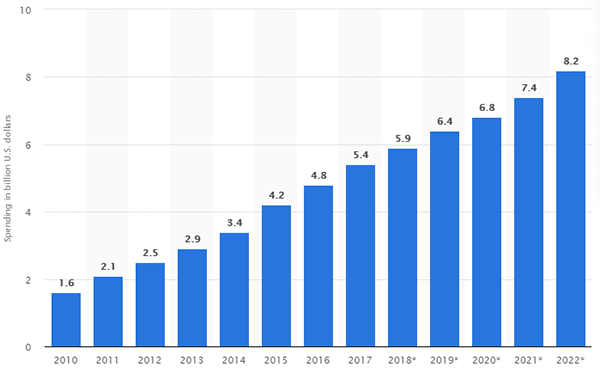
2. By 2025 Affiliate Marketing Will Surpass $30 Billion
According to a study conducted by Forrester Consulting, the affiliate marketing industry seems to be steadily growing at an average rate of 10% per year…
Based on a report published by Mhojos Research, in 2019, affiliate marketing was worth $17.3 billion, 33% more than the $13 billion it used to be worth 3 years earlier.
That’s a growth rate of 11% per year.
Assuming that it keeps expanding at the same rate, by 2025, affiliate marketing’s worth will have surpassed $30 billion.
- 2019: $17.3 billion
- 2020: $17.3 billion + 10% = $19.03 billion
- 2021: $19.03 billion + 10% = $20.93 billion
- 2022: $20.93 billion + 10% = $23.02 billion
- 2023: $23.02 billion + 10% = $25.32 billion
- 2024: $25.32 billion + 10% = $27.86 billion
- 2025: $27.86 billion + 10% = $30.64 billion
3. Interest in Affiliate Marketing Has Grew By 300% in Just 5 Years
Based on data drawn from Google Trends, over the past 5 years (2015 – 2020), the global popularity of the search term “affiliate marketing” has skyrocketed.
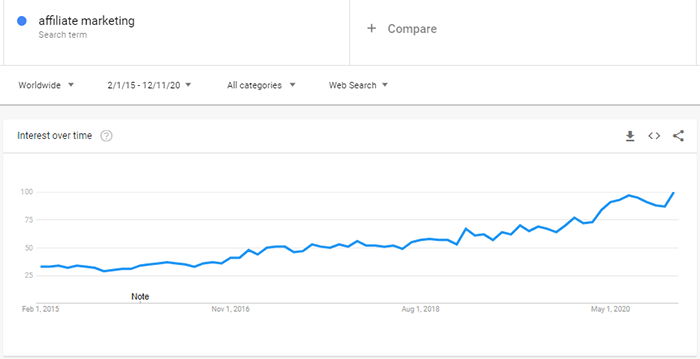
As you can see in the Google Trends chart right above, affiliate marketing’s popularity that used to be around 25 back in February 2015, has been steadily rising until reaching 100 in December 2020.
That’s a whopping 300% rise over a five year period!
In fact, right now, people’s interest in affiliate marketing seems to be at its highest point since Google Trends was launched back in 2004.
4. There Are Over 11,000 US-Based AM Programs
A report published by AM Navigator reveals that in 2018 there were around 11,400 affiliate programs in the US alone that revolved around any product/service that you could possibly imagine, such as:
- Clothes
- Fitness
- Food
- Computer Software
- Electronics
- Pets
- & more
8710 (76.4%) out of those 11,400 affiliate programs were provided by just 3 major affiliate networks:
- ShareASale: 5594 affiliate programs (49%)
- CJ Affiliate: 1709 affiliate programs (15%)
- Rakuten: 1412 affiliate programs (12.6%)
The remaining 2690 (23.6%) affiliate programs were provided either by smaller affiliate networks (Awin, Pepperjam, etc) or in-house by large corporations that didn’t belong to any affiliate network (Amazon, eBay, Apple, AliExpress, Walmart, etc).
Please note that at the time I’m writing this article (December 2020), all the figures just mentioned should be a lot higher than when they were initially published, 2 years earlier.
For instance, right now, ShareASale hosts 7800 affiliate programs compared to 5594 that it used to host back in 2018.
That’s a 40% increase in just 2 years!
5. 15% of All Digital Media Revenue Comes From Affiliate Marketing
An affiliate marketing report that was released by Business Insider in 2016, revealed that affiliate marketing drove as many online sales as email marketing, contributing to at least 15% of all the revenue generated within the digital media industry.
This means that affiliate marketing is the 3rd largest source of online sales, after organic search (21%), and paid search (19%).
Since affiliate marketing is steadily growing at a rate of 10% per year and those numbers were published back in 2015, chances are that right now affiliate marketing might be outperforming email and maybe even paid search.
6. Affiliate Marketing Drives 1% Of the UK’s GDP
A study conducted by IAB UK shown that in 2017, affiliate marketing was responsible for 1% of the UK’s GDP (Gross Domestic Product), actually exceeding the performance of the country’s entire agriculture sector.
In addition, that same study revealed that in 2017, affiliate marketing within the UK returned £16 for every £1 invested, resulting in £8.9 billion in sales, 9.2% more compared to the previous year.
7. The UK Market Received 5.6 Billion Affiliate Clicks in 2016
According to Awin’s 2017 report, in 2016, affiliate marketing along with lead generation campaigns produced around 5.6 billion clicks in the UK market.
Out of those 5.6 billion clicks, 171 million resulted in a transaction of some kind, whether that be a sale or a lead.
That’s a 3.05% conversion rate.
8. Affiliate Marketing’s Average Conversion Rate Is 1%
Speaking about conversion rates, Supermetrics supports that the average conversion rate of affiliate marketers ranges from 0.5% to 1%.
Since most affiliate marketers keep their conversion rates to themselves, these percentages are rough estimates based on conjecture, not actual facts.
That being said, I’m pretty sure that by employing the right A/B testing techniques, affiliate marketers should be able to increase their conversion rates up to 10% and maybe even more!
9. Amazon Has Gathered Over 1.3 Million Affiliates
According to Builtwith, since the launch of its affiliate program, Amazon has gathered over 1.3 million affiliates, out of which over 250,000 are actively utilizing it right now.
Contrary to Builtwith, Datanyze supports that the actual number of affiliates that are actively using the Amazon Associates program is just over 70,000.
Whatever the case, with a market share of more than 40% and over 6.4 million sellers, Amazon Associates remains the biggest affiliate program in the affiliate marketing landscape.
As a matter of fact, Amazon Associates majorly outperforms entire affiliate networks that consist of hundreds of different affiliate programs, such as:
- Rakuten: 13,395 affiliates – 7.97% market share
- CJ Affiliate: 13,220 affiliates – 7.87% market share
- SkimLinks: 12,727 affiliates – 7.57% market share
- ShareASale: 11,530 affiliates – 6.86% market share
- VigLink: 10,425 affiliates – 6.20% market share
- and Awin: 6,330 – 3.77 market share

10. 40% of Amazon's Revenue Comes from Affiliate Marketing
Amazon was one of the first companies to launch an online affiliate marketing program as early as 1996.
According to an article that was published by PRWeb, by 2013, Amazon was deriving almost 40% of its total global revenue through affiliate marketing.
I think that it’s perfectly safe to assume that Amazon wouldn’t be the colossus it is today if it weren’t for affiliate marketing.
11. Amazon’s Commission Rates Range From 1% - 10%
Amazon Associates’ commission rates range from 1% to 10% commissions per sale, depending on the category of the product sold.
For instance, smaller and cheaper products such as video games, toys, and computer components have lower commission rates compared to larger and more expensive products such as furniture, jewelry, luxury beauty products, and garden equipment.
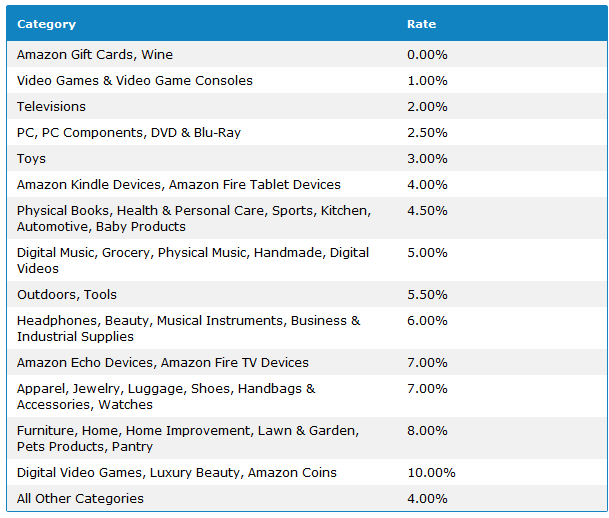
Important Update:
Beginning April 21, 2020, amidst the Coronavirus outbreak, Amazon slashed the commission rates of products in almost all its categories.
For example, commission rates for grocery products slid from 5% to 1% while commissions for product sales in the furniture and home improvement categories went down from 8% to 3%.
12. Over 50% of Affiliate-Referred Traffic Comes From Mobile Devices
Mobile data drawn by Awin from over 3.5 million online transactions that took place during the 1st quarter of 2016, revealed that 48.3% of all affiliate-referred traffic and 21.5% of all affiliate sales originated from a mobile device.
Furthermore, mobile traffic converted at 2.1% with an average order value of $67.01.
Unfortunately, this data hasn’t been updated since it was first released back in 2016.
Nonetheless, according to affise.com, as of July 2020, the percentage of people who access the internet via a mobile device has risen to a whopping 91%.
This means that right now, the amount of mobile-generated affiliate traffic and sales should have increased significantly.
13. 13% of Affiliate Marketers Make More Than $75,000/Year
One of the most common questions I’ve come across during my 4 years as a digital marketer is “How much money can someone earn with affiliate marketing?”
Well, according to an affiliate marketing benchmark report that was published by AffStat in 2016, 13% of all affiliate marketers make more than $75,000 per year.
To be more specific:
- 48.36% made less than $20K per year
- 11.1% made $20K – $30K per year
- 5.88% made $30K – $40K per year
- 2.16% made $40K – $50K per year
- 2.64% made $50K – $75K per year
- 3.19% made $75K – $100K per year
- 6.39% made $100K – $150K per year
- and 3.16% made over $150K per year
Those statistics place affiliate marketing among the most profitable online monetization models that currently exist.
To give you a frame of reference, according to some Multi-Level Marketing Statistics I put together last week, less than 3% of MLM reps make more than $25,000 per year while the percentage of affiliate marketers who make as much is about 25%.
This basically means that affiliate marketers are 8+ times more likely to make over $25,000 per year than MLM reps.
Furthermore, while 9.55% of affiliate marketers earn over $100K per year, only 0.05% of MLM reps manage to earn as much.
Subsequently, affiliate marketers are 191 times more likely to earn over $100K per year than MLM reps.
Lastly, a poll of 117 affiliate marketers that was held on the STM Forum revealed that:
- 18.80% made less than $20K per year
- 10.26% made $21K – $40K per year
- 10.26% made $41K – $80K per year
- 13.68% made $81K – $120K per year
- 12.82% made $121K – $200K per year
- 6.84% made $201K – $400K per year
- 7.69% made $401K – $800K per year
- 2.56% made $801K – $1 million per year
- 11.11% made $1.01 million – $2 million per year
- and 5.98 made over &2 million per year
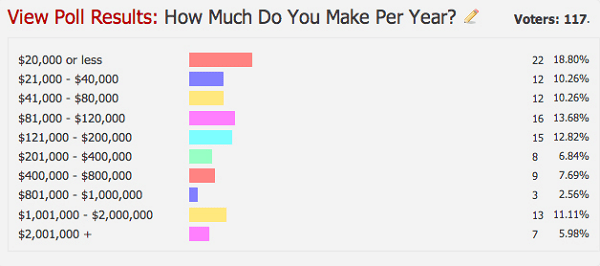
14. 81% of US-Based Merchants Leverage Affiliate Marketing
According to a report that was published back in 2016 by Forrester Consulting, over 81% of US-based merchants were utilizing affiliate marketing.
Out of those, 83% employed affiliate marketing to raise their brand awareness, and 79% to boost conversions, purchases, and customer engagement.
11% out of the remaining 19% that wasn’t utilizing affiliate marketing in their overall marketing strategy, claimed that they were planning to do so in the near future.
Furthermore, nearly 90% of the affiliate merchants that were surveyed considered their affiliate program as a very important aspect of their overall marketing strategy and about 40% supported that it was their leading customer acquisition channel (source: Inc.)
In addition, over 80% stated that they were devoting more than 10% of their marketing budgets to their affiliate programs.
As it seems, affiliate marketing is rising in popularity among small, medium, and big brands…
This is largely due to its cost-effectiveness and performance-based nature as an affiliate merchant doesn’t have to pay its affiliate publishers flat fees or monthly salaries but rather just commissions for successful leads and/or sales.
According to a VigLink study, 73% of affiliate merchants reported that the amount of revenue generated through their affiliate marketing program met their expectations, and 91% of them claimed that they were even planning to increase their affiliate marketing budget in the near future.
15. 84% of US-Based Publishers Utilize Affiliate Marketing
Based on that same Forrester report, 84% of all US-based publishers (bloggers, YouTubers, social media influencers, etc) monetize their content via affiliate marketing.
Over half of those affiliate publishers stated that affiliate marketing accounted for more than 20% of their annual revenue.
As a matter of fact, about 50% of the annual revenue of dearboss-iquit.com is generated as a direct result of affiliate marketing.
Furthermore, according to a survey conducted by VigLink, most publishers consider affiliate marketing the second-best monetization model after Google AdSense.
In addition, 34% of the publishers who received fewer than 5,000 monthly page views ranked affiliate marketing as their #1 way of generating revenue.
Lastly, that same VigLink survey revealed that:
- 65% claimed that affiliate marketing helped them generate additional revenue
- 76% stated that affiliate marketing made monetizing their website/content easy
- 45% supported that affiliate marketing did not disrupt their user experience
16. Content & Blogs Account for 40% of Affiliate Commissions in the US
According to Awin’s 2020 report, 40% of all affiliate commissions that are paid to US-based publishers, are generated through content and blogging websites.
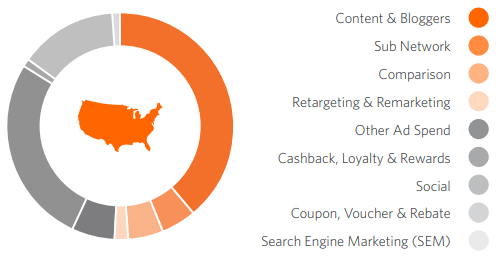
That’s probably the case because as the years pass by, an increasing amount of affiliate publishers invest the vast majority of their efforts in content marketing.
That being said…
17. Affiliate Content Has Grown by 175%
An article published by Awin supports that over the last few years, content produced by affiliate publishers (product reviews, how-to guides, YouTube videos, best-of lists, etc) has grown by 175%.
This is due to more and more affiliate marketers realizing that placing affiliate links within relevant content is one of the best ways towards skyrocketing conversion rates.
In addition, according to Demand Metric, content marketing campaigns cost 62% less to produce than traditional marketing campaigns while generating 300% more leads.
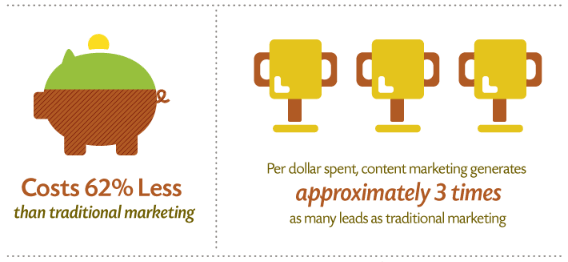
Lastly, this growth in content production has resulted in a 240% increase in the overall revenue generated by affiliate publishers worldwide.
18. Fashion is the Most Popular Affiliate Category
Research conducted by AM Navigator back in 2015 revealed the most popular affiliate marketing niche was “Fashion”, as products that fell under the Fashion category were being promoted in 18.7% of affiliate campaigns.
The second most popular category was Sports & Outdoors (14.6% share), followed by Health/Wellness & Beauty (11.1% share) and Travel (8.6% share).
This basically means that over 50% of affiliate campaigns promote products/services that fall under one of those 4 categories.
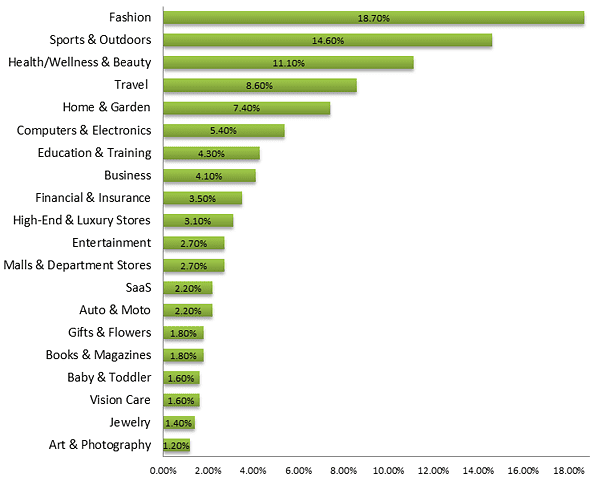
19. 0.67% of YouTube Videos Contain Affiliate Links
An empirical study of affiliate marketing disclosures on YouTube and Pinterest that was conducted by Princeton University showed that 3,472 out of 515,999 (0.67%) YouTube videos contained at least one affiliate link.
The YouTube videos that were more likely to be monetized via affiliate marketing fell under the following categories:
- Science & Technology (3.61%)
- How-to & Style (3.49%)
- Travel & Events (1.93%)
- Film & Animation (1.59%)
Furthermore, that same study revealed that 18,237 out of 2,140,462 (0.85%) Pinterest pins also contained at least one affiliate link.
The Pinterest pins that were more likely to be monetized via affiliate marketing fell under the following categories:
- Women’s Fashion (4.62%)
- Products (2.21%)
- Hair & Beauty (2.04%)
- Sports (1.63%)
As it seems, despite being a lot smaller than YouTube, Pinterest’s content was 0.20% more likely to be monetized via affiliate marketing.
That’s probably because according to a study that was released by Pinterest in 2016, 93% of Pinterest’s users utilize the platform to plan for or make purchases, while 52% claimed that they purchased something after coming across a relevant pin on Pinterest.
Lastly, the most commonly used affiliate program both on YouTube and Pinterest was Amazon’s Associate program with over 7K links within each platform.
20. 64.5% of Affiliate Marketers Are Under 44 Years Old
According to AffStat’s affiliate benchmark report, 64.5% of all affiliate marketers worldwide are under 44 years old.
More specifically,
- 5.08% are aged 18-24
- 27.55% are aged 25-34
- 31.86% are aged 35-44
- 22.41% are aged 45-54
- 8.76% are aged 55-64
- and 2.75% are aged over 65
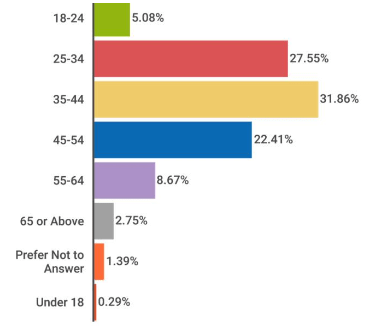
In addition, 54.23% of all affiliate marketers are male, 55.32% are married, 62.35% have children, 54.28% work from home, and 68.5% got started with affiliate marketing after 2010.
21. Over 69% of Affiliate Publishers Utilize SEO
The same AffStat report that we consulted in the previous section supports that the way 69.22% of affiliate publishers drive traffic to their websites/blogs is by leveraging SEO.
In addition, social networks are being utilized by 67.32% of affiliates, blogging by 64.48% of affiliates, while email marketing only by 41.47% of affiliates.
This means that SEO is the most commonly used traffic generation technique among affiliate publishers.
22. 81.4% of Affiliates Promote B2C Products/Services
The data on AffStat’s report reveals that the vast majority of affiliate marketers (81.4%) work with affiliate programs that revolve around B2C products/services while only 18.6% of them focus their efforts on promoting B2B offers.
That same report showed that the top 5 categories of products affiliate publishers prefer to promote are:
- Computer & Electronics (41%)
- Clothing & Apparel (40%)
- Online Services (30%)
- Accessories (29.5%)
- and Beauty (28%)
23. Over 57% of All Affiliate Publishers Reside in the US
Another conclusion drawn based on AffStat’s report is that a whopping 57.44% of all affiliate publishers that exist globally, reside in the US.
Out of all the United States, California is the one with the most affiliate publishers (13.53%), followed by:
- Florida (12.66%)
- New York (11.1%)
- Texas (10.22%)
- and Nevada (8.86%)
Lastly, the 5 countries with the most affiliate publishers following the US are:
- Canada (9.71%)
- Israel (5.88%)
- The UK (5.24%)
- Germany (2.87%)
- and The Netherlands (2.58%)
24. 63.83% of Affiliate Publishers Target US Consumers
Besides being the country with the most affiliate publishers, the US is also the primary target of the vast majority of affiliate publishers from all around the world.
According to AffStat, 63.83% of affiliate publishers primarily target US-based consumers.
Frankly, I wouldn’t expect anything different as currently, the US is #1 on Wikipedia’s list of largest consumer markets with a GDP of $20 trillion and over 328 million people.
In addition, based on SelectUSA, the household spending of US consumers is the highest in the world, accounting for more than a quarter of global household consumption.
In other words, if someone is after building a serious income with affiliate marketing, they just have to target a US-based audience.
Lastly, 35.19% of affiliate publishers picked Europe as their secondary target market.
No surprise there either…
25. ShareASale is the Most Used Affiliate Network
Based on that same AffStat report I’ve been mentioning for what feels like 1000 years, out of a total of 15 affiliate networks, the one with the most affiliate publishers was ShareASale.
More specifically, of all the affiliates that were surveyed, over 55% stated that they worked with ShareASale.
As a matter of fact, according to an article published by AM Navigator, ShareASale surpassed the 1,000,000 registered affiliate accounts back in 2014.
The 5 affiliate networks that affiliate publishers worked with the most after ShareASale, were:
- CJ Affiliate (43%)
- Rakuten (40%)
- ClickBank (36%)
- Avangate (31%)
- and LinkConnector (30%)
26. 71% of US-Based Affiliates Work With 3+ Affiliate Networks
Based on the Forrester report I mentioned earlier in this article, 71% of US affiliate publishers work with 3 or more affiliate networks.
More specifically:
- 6% work with 1 affiliate network
- 23% work with 2 affiliate networks
- 39% work with 3 affiliate networks
- 12% work with 4 affiliate networks
- and 20% work with 5+ affiliate networks
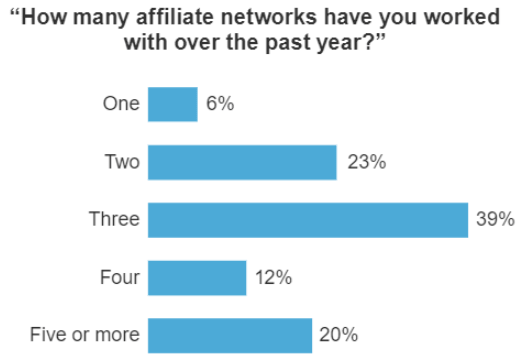
Likewise, AffStat reported that 42% of affiliate publishers belong to 1–10 affiliate programs.
27. Most Affiliate Publishers Lack Proper Training
According to AffStat, the main thing that holds most affiliate publishers back from generating more revenue is the lack of proper training.
Truth is that despite the fact that there exist tons of affiliate marketing courses out there, the vast majority of them are of extremely low-quality, created just to put money in the pockets of their creators.
Having said that, if you’re just getting started as an affiliate publisher and you’re in need of proper affiliate training, I suggest that you check out my list of the Best Affiliate Marketing Courses.
28. Affiliate Marketing is the Most Desired Digital Skill
As stated in an article published by AM Navigator, out of over 1,000 marketing professionals that were polled in a survey, 40% stated that their most sought-after digital marketing skill is affiliate marketing, surpassing even mobile marketing (39%), SEO (37%), and CRO (36%).
The study concluded that this was the case because affiliate marketing was the skill that most marketers didn’t possess, hence it was the one that marketers would want to improve the most.
29. Top Affiliate Publishers Earn 6-7 Figures Per Year
Fortunately, there’s no shortage of amazing affiliate marketing success stories…
Nowadays, there are hundreds of affiliate publishers that are pocketing 6 to 7 figures per year!
For instance, up until December 2017, affiliate publisher Pat Flynn (owner of smartpassiveincome.com) used to publish monthly income reports, according to which he was pocketing commissions that ranged anywhere between $50,000 to $100,000 per month!
Another example is that of Robby Blanchard who went from struggling gym owner to earning over $30,000 per week by promoting ClickBank products through FB paid ads. Robby has launched a course called “Commission Hero“ that lays down the exact 3-step system he utilizes to generate that much money.
Matt Diggity who used to be an electrical engineer is now building and selling high-authority affiliate websites for over $100,000 each. Matt runs a course called “The Affiliate Lab“ where he outlines all the strategies and techniques he uses to build, scale, and sell his websites for tens of thousands of dollars.
Some other affiliate publishers that generate 6-7 figure per year are:
- Neil Patel (owner of neilpatel.com)
- John Chow (owner of johnchow.com)
- Mark Ling (runs the Affilorama course)
- Matthew Woodward (owner of matthewwoodward.co.uk)
- Jon Morrow (owner of smartblogger.com)
- Devon Brown (runs the 12 Minute Affiliate course)
- Doug Cunnington (runs the Five Figure Niche Site course)
- & more
30. An Affiliate Made $7 Million in Commissions in One Year
An article published on entrepreneur.com outlines the story of multi-millionaire affiliate marketer Jason Stone…
Back in 2014, Jason Stone launched the Instagram page @millionaire_mentor.
By 2016, Jason had grown @millionaire_mentor to over 2.5 million followers.
Within the next 12 months, Stone had managed to net a whopping $7 million in commissions just by promoting affiliate offers to his followers – without selling even a single product or service of his own.
Until now (December 2020), @millionaire_mentor has accumulated over 7 million followers!
Having said that, we can safely assume that currently, Jason’s yearly affiliate commissions should have surpassed the $20 million dollars.
Infographic

If you’d like to embed this infographic on your website, just copy and paste the code right below to your HTML editor:
<a href="https://dearboss-iquit.com/" target="_blank" rel="noopener"><img decoding="async" class="aligncenter" src="https://dearboss-iquit.com/wp-content/uploads/2020/12/Affiliate-Marketing-Statistics-Infographic.png" alt="Affiliate Marketing Statistics Infographic" width="600"></a>
<p style="text-align: center;">Created by <a href="https://dearboss-iquit.com">Dear Boss I Quit</a></p>
Conclusion
The affiliate marketing statistics outlined in this article support that the upwards trajectory affiliate marketing has been experiencing since it was first conceived back in 1989, isn’t going to stop anytime soon.
On the contrary, affiliate marketing is expected to be soon outperforming all other digital marketing channels, including SEO, PPC, email marketing, SEM, social media marketing, etc.
As a matter of fact, in the eyes of some, affiliate marketing is the future of digital marketing…
This doesn’t come as such a surprise considering that affiliate marketing offers tremendous amounts of value to all parties involved with it, be it
- merchants who get to increase their sales and brand awareness cost-effectively
- publishers who get to earn commissions with practically zero monetary investment and minimal hustle
- and even buyers who can get their hands on valuable content that’ll help them make informed purchasing decisions
Concluding, whether you’re a merchant who’s after extending their reach or an ordinary person who’s after building an income online, frankly, there’s no better time to get started with affiliate marketing than now.
Have any comments or questions?
Please leave a comment right below or contact me at harry@dearboss-iquit.com
I’ll be more than happy to help you out!
Best wishes and stay safe,
Harry, Founder & Editor at dearboss-iquit.com



